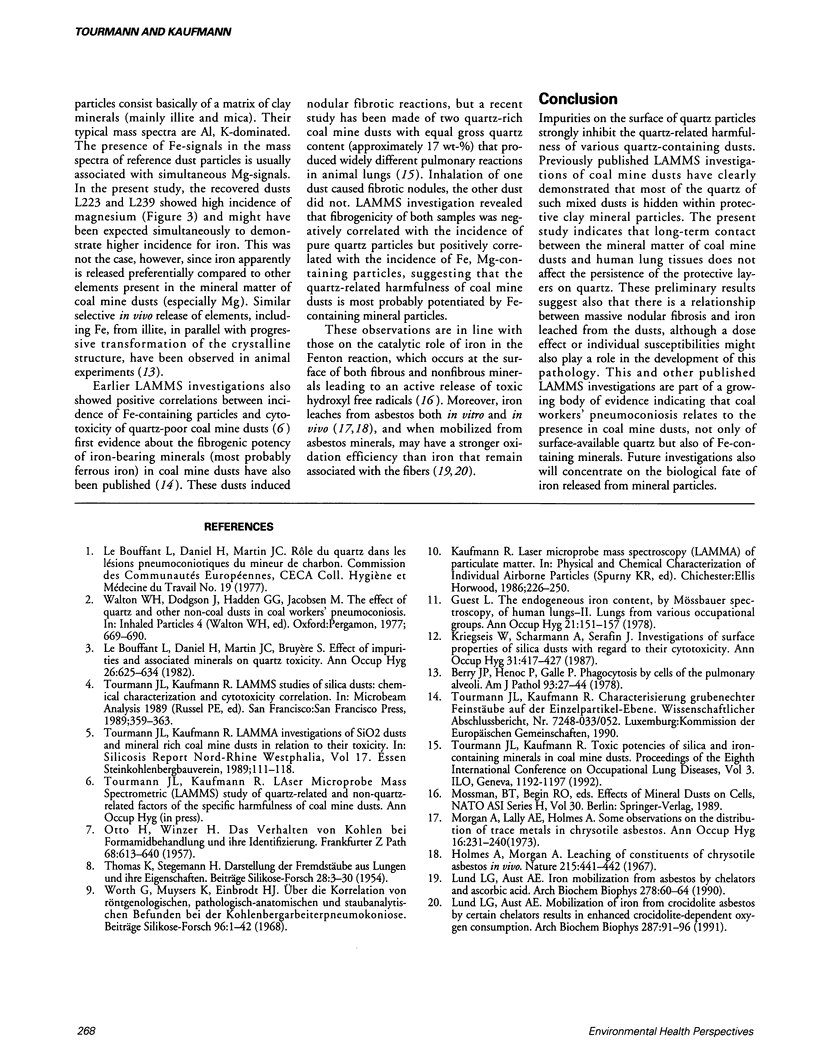Abstract
Toxic potency of quartz-containing dusts, including coal mine dusts, is usually inhibited by protective clay mineral layers on the surface of quartz particles. This investigation of 11 dusts recovered from lungs of coal miners with different silicosis grade shows that such layers persist during long-term contact with human lung tissues. On the other hand, the results suggest that an apparently preferential release of iron occurred in lungs with massive fibrosis. These preliminary results support the hypothesis of an iron-related harmfulness of coal mine dusts.
Full text
PDF



Selected References
These references are in PubMed. This may not be the complete list of references from this article.
- Berry J. P., Henoc P., Galle P. Phagocytosis by cells of the pulmonary alveoli. Transformation of crystalline particles. Am J Pathol. 1978 Oct;93(1):27–44. [PMC free article] [PubMed] [Google Scholar]
- Guest L. The endogenous iron content, by Mössbauer spectroscopy, of human lungs--II. Lungs from various occupational groups. Ann Occup Hyg. 1978 Aug;21(2):151–157. doi: 10.1093/annhyg/21.2.151. [DOI] [PubMed] [Google Scholar]
- Holmes A., Morgan A. Leahing of constituents of chrysotile asbestos in vivo. Nature. 1967 Jul 22;215(5099):441–442. doi: 10.1038/215441b0. [DOI] [PubMed] [Google Scholar]
- Kriegseis W., Scharmann A., Serafin J. Investigations of surface properties of silica dusts with regard to their cytotoxicity. Ann Occup Hyg. 1987;31(4A):417–427. doi: 10.1093/annhyg/31.4a.417. [DOI] [PubMed] [Google Scholar]
- Le Bouffant L., Daniel H., Martin J. C., Bruyère S. Effect of impurities and associated minerals on quartz toxicity. Ann Occup Hyg. 1982;26(1-4):625–634. [PubMed] [Google Scholar]
- Lund L. G., Aust A. E. Iron mobilization from asbestos by chelators and ascorbic acid. Arch Biochem Biophys. 1990 Apr;278(1):61–64. doi: 10.1016/0003-9861(90)90231-m. [DOI] [PubMed] [Google Scholar]
- Lund L. G., Aust A. E. Mobilization of iron from crocidolite asbestos by certain chelators results in enhanced crocidolite-dependent oxygen consumption. Arch Biochem Biophys. 1991 May 15;287(1):91–96. doi: 10.1016/0003-9861(91)90392-v. [DOI] [PubMed] [Google Scholar]
- Morgan A., Lally A. E., Holmes A. Some observations on the distribution of trace metals in chrysotile asbestos. Ann Occup Hyg. 1973 Nov;16(3):231–240. doi: 10.1093/annhyg/16.3.231. [DOI] [PubMed] [Google Scholar]
- Walton W. H., Dodgson J., Hadden G. G., Jacobsen M. The effect of quartz and other non-coal dusts in coalworkers' pneumoconiosis. Part I: Epidemiological studies. Inhaled Part. 1975 Sep;4(Pt 2):669–690. [PubMed] [Google Scholar]
- Worth G., Muysers K., Einbrodt H. J. Uber die Korrelationen von rötgenologischen, pathologisch-anatomischen und staubanalytischen Befunden bei der Kohlenbergarbeiterpneumokoniose. Beitr Silikoseforsch. 1968;96:1–41. [PubMed] [Google Scholar]


